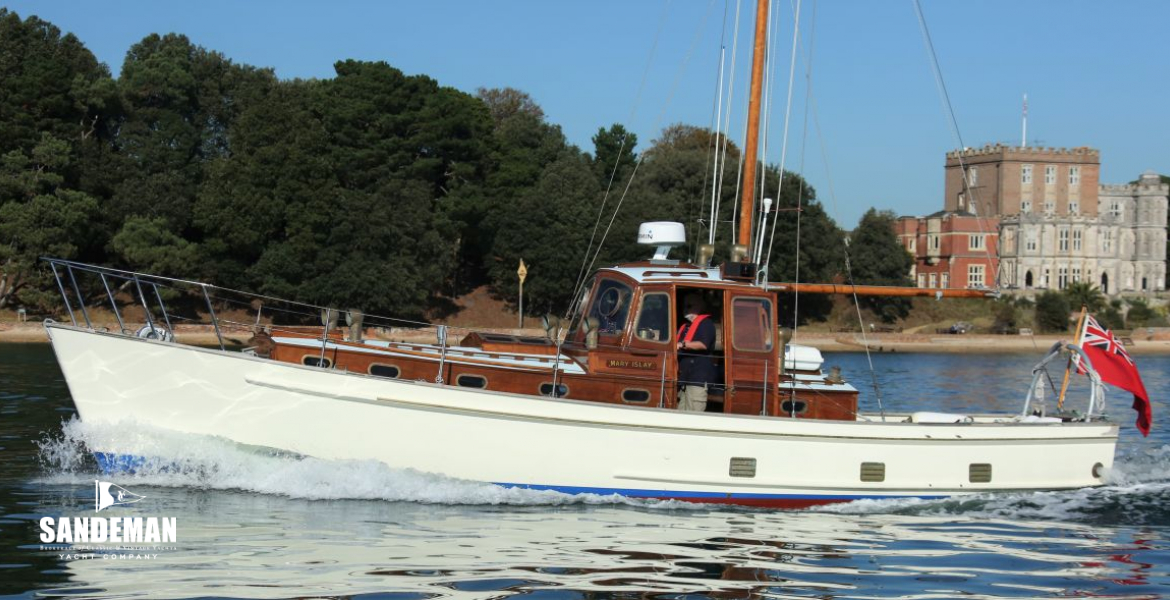
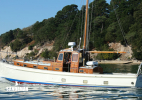
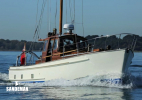
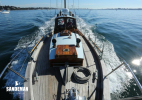
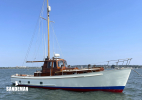
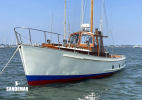
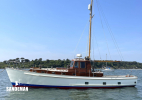
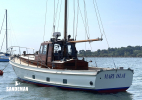

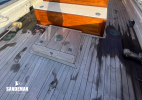

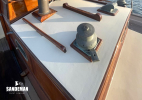
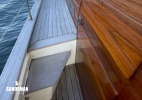
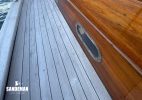
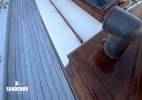
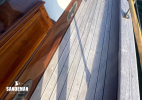
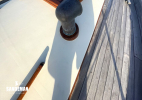
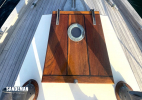
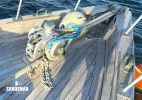
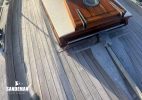
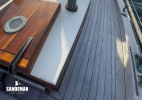
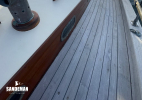
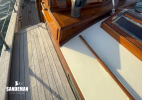


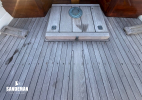

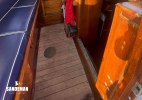
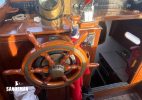
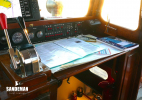

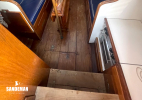
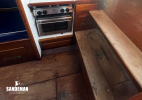

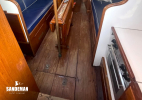
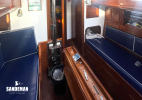
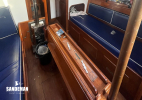
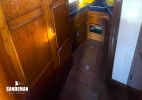

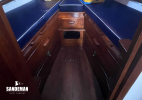


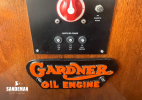
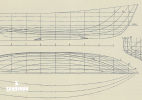
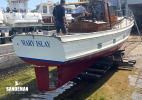
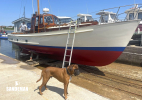
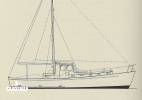
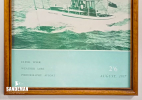
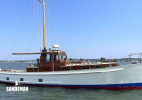
| Designer | John E. Powell |
|---|---|
| Builder | Aeromarine Ltd., Emsworth |
| Date | 1956 |
| Length overall | 37 ft 0 in / 11.28 m |
| Length deck | 37 ft 0 in / 11.28 m |
| Length waterline | 34 ft 0 in / 10.36 m |
|---|---|
| Beam | 10 ft 6 in / 3.2 m |
| Draft | 3 ft 9 in / 1.14 m |
| Displacement | 10 Tonnes |
| Construction | Carvel teak on oak and rock elm |
| Engine | Gardner 4LW 62 hp Diesel |
|---|---|
| Location | Jersey Channel Islands |
| Price | Sold |
These details are provisional and may be amended
In MARY ISLAY, John E. Powell - Aeromarine’s highly proficient in-house yacht designer who would subsequently become better known as an alloy spar maker - perfected a highly attractive and purposeful fusion of workboat type with yacht styling and construction standards. Dubbed a “fishing yacht” on launch, this teak wonder achieves a whole lot in her overall length, with well thought-out space above and below for cruising and pottering by family and friends. Sensibly and economically powered by a trusty Gardner 4LW, and given more than just deserts professionally in current ownership, MARY ISLAY is a very special love affair waiting to happen.
Interested in MARY ISLAY in more detail.
2022-2023 REFIT: TRADITIONAL SHIPWRIGHT SERVICES, POOLE
- All windows removed
- External varnish stripped and refinished in Awlwood
- Roofs repainted with fittings removed and refastened
- All windows replaced
- Topsides refinished
- Antifouling refinished
- Engine and systems serviced/ overhauled
2016-2020: MAJOR REFIT & OTHER WORKS: TRADITIONAL SHIPWRIGHT SERVICES, POOLE
Having been laid-up on a spring tide mooring at St Helier from 2006, she was shipped on a 40ft platform unit from Jersey to Poole in August 2016. Towed to Traditional Shipwright Services, Poole, she was hauled into their shed and engine removed. She was given a through clean and most fittings, shaft, tube and rudder assembly removed. Over the next two years, steady work was done around regular customer operations.
The main hull structural work included a new oak inner stern knee. Other work included replacing a section port and starboard of the main aft deck stringer/shelf at the fo'c'sle step. Sections of the main cabin and wheelhouse roofs were replaced and new epoxied cloth covers fitted. The engine room roof and mast step beam were replaced with new. Oak fenders each side replaced and new brass strip added.
New stainless steel fuel tanks and pipework were fitted and some engine room insulation replaced. The engine wiring loom, instrument panel, switchboards and all electrical wiring replaced and new LED lighting fitted to original brass fittings. All seacocks removed, re-seated, new bolts, new toilet pipework, sink drains, bilge pump hoses and new pumps fitted. A new exhaust pipe, watertrap, u-bend and outlet were also fitted.
Surveyor inspected all hull planking and fastenings and except for 5 bronze screws, which were replaced, all found in good order. Hull and houses stripped back to bare wood, houses epoxy coated and re-varnished. Hull re-stoppered, primed, undercoated, antifouled and topsides finished. About 100 bronze deck screws were removed, holes re-countersunk, refitted and re-plugged. RNLI Scuppers were removed, overhauled and refitted. The mast had new internal aerial & electric cables fitted.
In 2019 the mast was re-varnished and new SS standing rigging fitted. In 2020 a new starboard beaching leg was made and fitted.
MARY ISLAY was launched at Emsworth on Thursday 21st March 1957 for aviator, merchant banker and eventual airline industry executive Sir Giles Guthrie, Bt., and named after his mother. He had been an RAF fighter pilot in WWII and would become a board member of British European Airways (BEA) and chairman and chief executive British Overseas Airways Corporation (BOAC), predecessors of British Airways. Guthrie moored MARY ISLAY on the main channel moorings of the Hamble River off the Royal Southern YC and The Bugle pub. Yachting Monthly magazine covered her build and first year in Dec 1956 and March 1958, and she features on the cover of the August 1957 edition of Yachting World, and in their 1957 Annual. In 1962 Guthrie sold her when he became chairman of BOAC and she was then based on the Beaulieu River. Subsequent owners kept her in Northumberland, then on the River Thames at Datchet. She was fitted with beaching legs and davits at Cowes on her way to Jersey in 1986 to be based at St Aubin. MARY ISLAY's last Jersey owner purchased her in 1992, with her longest voyage being to the 'Brest 96 & Douarnenez traditional boat festivals. Regular shorter runs were mainly to local bays, Les Minquiers, and Île de Bréhat in Brittany.
Poole in Dorset is the traditional UK hub for the Channel Islands and it is not uncommon for Islands based yachts to be maintained and refitted there. MARY ISLAY became a regular client of Poole-based Traditional Shipwright Services where her wonderful lines and arrangement won many admirers. One of TSS's existing clients purchased MARY ISLAY while in for refit in 2022 and has used her for family pottering in Poole Harbour where she continues to be wintered indoors, and is professionally maintained by Traditional Shipwright Services.
©2024 Iain McAllister/ Sandeman Yacht Company Ltd.
John Everett Powell began his working life in 1937 as an apprentice boatbuilder at the brand new and impressive Sussex Yacht Works, Shoreham-on-Sea, where he was immediately recognised as a very bright spark and later encouraged by his drawing office friend Austin Farrar - who had worked with Robert Clark - into a career change to naval architecture that did him no harm. At this time Sussex Yacht Works was mostly involved in building Clark’s early designs, including the series-built Mystery Class, and winning offshore racers ERIVALE and JOHN DORY. Impressions would have been lasting.
During the Second World War, Powell followed Farrar into a British Admiralty research department led by Charles Currey that successfully developed netting torpedo protection for warships, including time spent on the Firth of Clyde where he may have first encountered his future collaborator, John Illingworth.
Post-War - after a period as naval architect back in Shoreham-by-Sea at the renamed Sussex Shipbuilding Company, to his own account (including building in his Kingston-by-Sea back garden a 30 foot sloop for himself), and with Robert Clark, Jack Laurent Giles (notably on the revolutionary Sussex Shipbuilding Co. built aluminium ocean racer GULVAIN), and four years as an assistant to Arthur Robb - between 1952 and 1958 ‘Johnny’ Power was yard manager and naval architect/ designer at John Illingworth’s Aeromarine yard at Emsworth. Here Powell’s design output included some famous contemporary small and ‘JOG’ ocean racers such as ARTICA II, BELMORE, MOUSE OF MALHAM, and WISTA.
During the 1948-1949 build of GULVAIN, along with Jack Rawlings - owner of both the boat and her builders - John Powell had taken out a patent on extruded aluminium alloy mast construction. Ten years later, Powell left Aeromarine to become a pioneer manufacturer of such spars as ‘Sparlight’, later John Powell Masts, eventually taken over by Proctor. His design role at Aeromarine was filled by Angus Primrose.
In his autobiography ‘The Malham Story’. John Illingworth speaks highly of John Powell’s abilities. He deserves to be better remembered. MARY ISLAY is a very fine testament.
©2024 Iain McAllister/ Sandeman Yacht Company Ltd.
(with acknowledgement to David Chivers's wonderful 2007 biography of Austin Farrar, 'An Eye for Innovation')
- Originally built to Lloyds 100A1
- Carvel 1¼ in teak on oak frames and rock elm timbers
- Bronze and copper fastened
- Oak centreline
- 1½ Tonne lead keel
- 1 in / 25 mm Teak deck
- Teak superstructure with western red cedar roofs
- Semi-balanced wooden rudder
FROM AFT
AFT DECK
- 2 x Rubbing strakes port and starboard
- Open aft deck; stepped foredeck
- Aft deck bulwark with internal ceilings and broad raw teak capping
- 550 mm stanchions with guard wires; stainless steel pulpit
- 3 x Bronze 1950s RNLI-type NR scupper drains port and starboard
- Opening/ locking RNLI-style taffrail mooring fairleads port and starboard
- Midships open taffrail mooring fairlead
- Fixed aft spring mooring fairleads at rail port and starboard
- Quarter lockers port and starboard: exhaust u-bend, shore power socket; stowage
- 1 x Pair galvanized steel tube davits
- Steering flat hatch aft, deck aft
- Shaft and gland access hatch aft deck fwd
AFT TRUNK OVER ENGINE ROOM
- Varnished teak uprights
- 1 x Fixed port light port and starboard
- 2 x Revon bronze vent cowls
- Outlet cowl vent
- Stowage chocks for liferaft
- Lift off painted roof for engine access
WHEELHOUSE
- Varnished teak wheelhouse
- Painted glass cloth roof
- Sliding doors access port and starboard
- Step lockers port and starboard house for Camping Gaz cylinders
- 2 x Revon bronze vent cowls
- Radome
- Grab rails port and starboard
- Running lights port and starboard
FORWARD TRUNK CABIN OVER SALOON AND PART OF FORECABIN
- Painted glass cloth roof
- Grab rails port and starboard
- Varnished teak butterfly hatch over saloon
- Stainless steel diesel heater flue
- 2 x Revon bronze vent cowls
- Varnished teak forehatch over forecabin; bronze portlight
- 5 x Fixed port lights port and starboard
FOREDECK
- Danforth anchor stowage
- Closed fwd spring mooring fairleads at rail port and starboard
- Closed headline mooring fairleads port and starboard
- Galvanised bow roller in bulwark with pin and pawl
GROUND TACKLE
- Original Simpson-Lawrence SL500 manual windlass
- Completely overhauled from best parts of 2 units (2018)
- Plinth pad (2018)
- 20 kg Danforth type anchor chocked on foredeck
- 65 m of 10 mm galvanised anchor chain
- Spare Fisherman anchor with 20 m of chain + 50 m of 18 mm warp
- Stowed under the port saloon berth
- Anchor chain snubber
BERTHS FOR 4 IN 2 CABINS
WHEELHOUSE
- Traditional ship’s wheel to port
- Hinged companionway hatch to fwd accommodation to starboard
- Closed companionway hatch forms folded Admiralty chart table
- Chart stowage in wheelhouse roof
- Access aft to engine space
DOWN FORWARD TO ATHWARTSHIPS GALLEY
To starboard
- Fridge box with cooler plate and remote compressor
- Plastimo Neptune 2500 2-burner hob with grill and oven
- Cover over hob
To port
- Stainless steel sink
- Work area
- China and utensil stowage
- Lockers under
- White/ red LED lights
- Food locker aft doubles as electrical/ electronics/ steering gear locker
FORWARD TO SALOON
- Settee/ berths port and starboard
- Stowage behind backrests and below
- Lockers and shelves outboard
- Drop leaf table
- Blakes-Taylors 079D drip feed diesel heater fwd to port
- Fuel to heater supplied by an SU electric pump from port main fuel tank
- 2 x Brass reading lamps
- 1 x LED lantern
FORWARD TO WALK THROUGH WC COMPARTMENT
- Fore and aft doors close off compartment
- Blakes Lavac sea toilet to port
- Slide in/out china washbasin with hot and cold fresh water
- Hanging locker and drawer to starboard
FORWARD TO FORECABIN
- V-berths port and starboard
- Slots for fill in panels to make double berth
- Drawers under
- Open boot locker forward
- Access to chain locker
- LED lamp above
- 2 x Brass reading lamps
MECHANICAL
- Gardner 4LW Diesel engine (1964 – rebuilt 2006 and 2017)
- 62 hp @ 1500 RPM
- PRM 500 Gearbox
- Flexible drive to 2 in/ 50mm Stainless steel propeller shaft
- Twinflex Layrub joints with intermediate shaft
- Timken thrust block with roller bearings
- Bronze, oil lubricated shaft tube
- Traditional packing gland inboard
- 27 in 3-bladed bronze propeller
- Bronze steering fittings – cable steering
ELECTRICAL
- 24 V System (2018)
- 4 x Rolls 6FS-220FS lead acid house batteries
- 2 x Yuasa 12V, 115Ah, 1000A engine start batteries
- Electrical panel in wheelhouse
- Prestolite Leece-Neville 8LHA 24 Volt 45/75 Amp alternator
- Original engine dynamo drive by a 1” toothed flexible belt
- CTek 4A Multi XT4000 and 14A MultiXT14000 smart battery chargers
- 2nd 240V feed supplies a 13A socket and switch for immersion
- 24 & 12 Volt supply panel stbd side of wheelhouse engine instrument panel
- High temp. engine exhaust alarm; engine and gearbox temp. and pressure gauges/alarms
- ISSPRO tachometer (0-2000 rpm) run by electric pulses off the alternator.
TANKAGE
Fuel
- Stainless steel fuel tanks port and starboard of engine (2018)
- Capacity c 300 litres each
- 2 x Separ 2000 primary fuel filters
Fresh water
- Stainless steel 240 Litre tank under wheelhouse
- Fresh water pump to galley and WC
- Isotherm calorifier and immersion heater
Salt water
- Deck wash pump with hose connection
NAVIGATION
- Stowe Dataline-X log and echo sounder
- Analogue meters above the wheelhouse windows
- 24 V Belt-driven Kent Clearview screens port and starboard
- Plastimo Offshore 135 steering compass in brass binnacle
- Emergency binnacle oil lamp
- Analogue readout for KVH electronic compass
- Garmin GPSmap 10” chartplotter screen unit
- NMEA2000 system
- Garmin 18HD 4kw Raydome on hinged Scanstrut tower
- Garmin GPS 19X antenna on wheelhouse roof mast
- Garmin Airmar B744 Triducer log/echosounder
- Digital Yacht ‘AIS 100’ AIS receiver
- Navico Wheelpilot WP5000; toothed belt drive to steering wheel
- Controller/compass unit at extreme stbd side of the Instrument/switch panel
COMMUNICATIONS
- ICOM DSC IC-M232G VHF transceiver
- Changeable aerial leads to a masthead or roof 6 ft whip (used for AIS)
RIG
- Silver spruce mast and boom
- Original galvanised fittings
- Mast is tabernacle stepped and can be lowered aft
- Portable galvanised steel crutch
- Mast re-glued (1987)
- Stainless steel standing rigging (2019)
- 2 x Bronze halyard winches
SAILS
- Provision for a 107 sq ft / 10 sq m “Mizzen” (sail not in inventory)
- Boom sheets port and starboard cleated outside wheelhouse doors
- 277 sq ft / 26 sq m Genoa
- Sheets to bronze winches port and starboard on aft trunk cabin
- RFD 4-person canister Seasaver Plus liferaft (1997)
- Oceansignal RescueME EPIRB1 in wheelhouse (2018)
- Electronic Distress Flare EDF1 (2018).
- 20m throw-line bag
- KIM MOB rescue sling
- 2 x Horseshoe lifebuoys, one with Light and flag buoy
- A set of distress flares in a waterproof
- 1 L water mist fire extinguisher in forecabin
- 1 L foam fire extinguisher amidships
- 3 L water mist fire extinguisher at companionway
- ‘SeaFire’ FD175A FM200 auto fire extinguishing unit in engine room
- Auto electric bilge pumps in forecabin, engine room (manual switch) and shaft gland
- Manual bilge pump is fitted in engine room
- Emergency steering galvanized steel tiller stowed in steering flat
- Beaching legs
- Selection of engine consumables spares in a toolbox
- Tools in toolboxes
- 8 x Fenders
- Various mooring and other lines mostly in plastic crates
- Hella rubberised portable hand searchlight
Under power: Nigel Sharp
Contact us to discuss MARY ISLAY in more detail.
These particulars have been prepared from information provided by the vendors and are intended as a general guide. The purchaser should confirm details of concern to them by survey or engineers inspection. The purchaser should also ensure that the purchase contract properly reflects their concerns and specifies details on which they wish to rely.